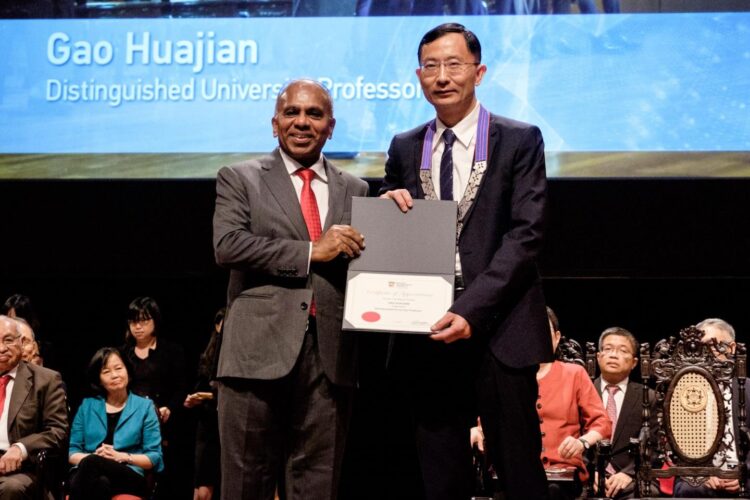Research has seen him scrutinising geckos, bones, and conch shells

Credit: NTU Singapore
As a child, Professor Gao Huajian, Distinguished University Professor at Nanyang Technological University, Singapore (NTU Singapore), would stare at aeroplanes and birds and wonder about the driving principle behind the flight of two seemingly different objects. This child-like curiosity would later drive much of his research as an academic.
Prof Gao never considered himself an exceptionally bright student, but his passion for all things science saw him securing a place in Xi’an Jiaotong University, China at the age of 15.
Over three decades of research, more than 500 published research papers, and numerous international honours and awards later, Professor Gao’s research contributions are now recognised by the American Society of Mechanical Engineers (ASME) with the prestigious 2021 ASME Timoshenko Medal, the highest form of recognition in his field of applied mechanics.
Prof Gao, who is from the NTU School of Mechanical and Aerospace Engineering, is recognised for his “pioneering contributions to nanomechanics of engineering and biological systems, a new research field at the interface of solid mechanics, materials science and biophysics,” said ASME.
The former Stanford and Brown University professor joins a distinguished list of 64 previous recipients of the ASME Timoshenko Medal, including NTU Singapore President and inaugural Distinguished University Professor Subra Suresh; Yuan-Cheng Fung, known as the ‘father of modern biomechanics’; and Jakob Ackeret, one of the foremost aeronautics experts of 20th century.
Prof Gao said: “I am very honoured and humbled to be selected for the ASME Timoshenko Medal, the highest form of honour in my field of research, especially when there are so many great colleagues in the field who are equally, if not more deserving. This award recognises not just my contributions, but also that of my collaborators, post-docs, and students, and I share this recognition with them.”
Prof Gao, who formerly headed the Max Planck Institute for Metals Research in Germany, also attributes his success to his child-like wonder.
“I’m like a kid with a lot of curiosity, working with my colleagues to make sense of some scattered data and tell a story that is consistent with all the data we have. That’s the great thing about being a scientist. I always feel like I am learning new things, acquiring new knowledge, and that’s what excites me. It’s very rejuvenating, and it keeps me young,” said Prof Gao.
Finding the unexpected in nature
An author of more than 500 scientific articles, including in renowned journals such as Nature and Advanced Materials, Prof Gao’s multi-disciplinary research runs the gamut from finding new ways to make materials tougher, to studying ways to deliver nanomedicine into cells.
A big part of Prof Gao’s research draws inspiration from nature, be it the natural ‘glue’ that give geckos their adhesive properties, the way insects change colour through altering their microstructure, or the biological makeup of bones and shells that give them their toughness.
He said: “I like to look at nature and find the unexpected and unanticipated. Materials found in nature are synthesised molecule by molecule and are optimised, having gone through evolution. We want to understand these materials, then do better than nature.”
More recently, Prof Gao has been looking into solving problems arising from a hydrogen economy, such as storing hydrogen safely given that pipes, containers and vessels are currently designed to store natural gas, oil, and petroleum.
His drive to extend the frontiers of knowledge through science has earned him numerous honours and awards, including the Guggenheim Memorial Fellowship in 1995; the Rodney Hill Prize in Solid Mechanics from the International Union of Theoretical and Applied Mechanics and the Alexander von Humboldt Research Award, both in 2012; and the 2015 Nadai Medal, the highest recognition of ASME’s Materials Division.
He has also been elected to the US National Academies of Sciences and Engineering, the American Academy of Arts and Sciences, as well as to other prestigious academies around the world, including the Academies of Sciences in Germany and China.
Said Prof Gao: “Science is a big community, and I enjoy working with students and colleagues to find solutions and surprises together in our exploration. I want to continue asking the right questions, find a clever way to answer them, and hopefully my work will be applied or used in some way. This process is what I enjoy.”
The formal presentation of the 2021 ASME Timoshenko Medal will take place at the Applied Mechanics Division Awards Ceremony during the virtual ASME Mechanical Engineering Congress & Exposition held from 1 to 4 November 2021.
###
Media contact:
Foo Jie Ying
Manager, Corporate Communications Office
Nanyang Technological University
Email: [email protected]
About Nanyang Technological University, Singapore
A research-intensive public university, Nanyang Technological University, Singapore (NTU Singapore) has 33,000 undergraduate and postgraduate students in the Engineering, Business, Science, Humanities, Arts, & Social Sciences, and Graduate colleges. It also has a medical school, the Lee Kong Chian School of Medicine, established jointly with Imperial College London.
NTU is also home to world-class autonomous institutes – the National Institute of Education, S Rajaratnam School of International Studies, Earth Observatory of Singapore, and Singapore Centre for Environmental Life Sciences Engineering – and various leading research centres such as the Nanyang Environment & Water Research Institute (NEWRI) and Energy Research Institute @ NTU (ERI@N).
Ranked amongst the world’s top universities by QS, NTU has also been named the world’s top young university for the past seven years. The University’s main campus is frequently listed among the Top 15 most beautiful university campuses in the world and has 57 Green Mark-certified (equivalent to LEED-certified) buildings, of which 95% are certified Green Mark Platinum. Apart from its main campus, NTU also has a campus in Novena, Singapore’s healthcare district.
Under the NTU Smart Campus vision, the University harnesses the power of digital technology and tech-enabled solutions to support better learning and living experiences, the discovery of new knowledge, and the sustainability of resources.
For more information, visit http://www.
Media Contact
Foo Jieying
[email protected]





